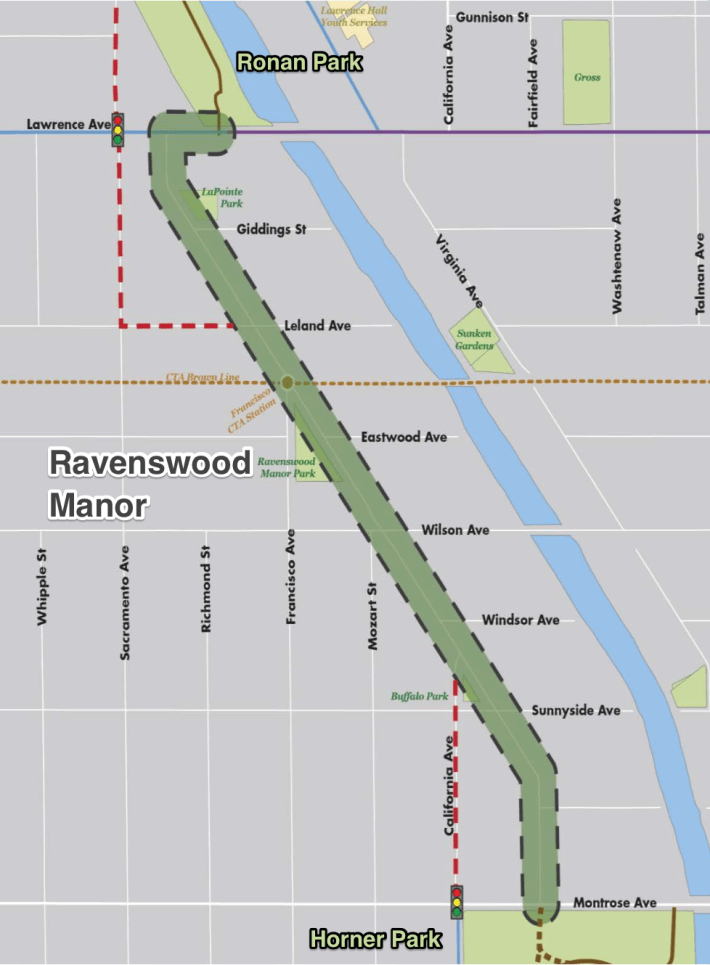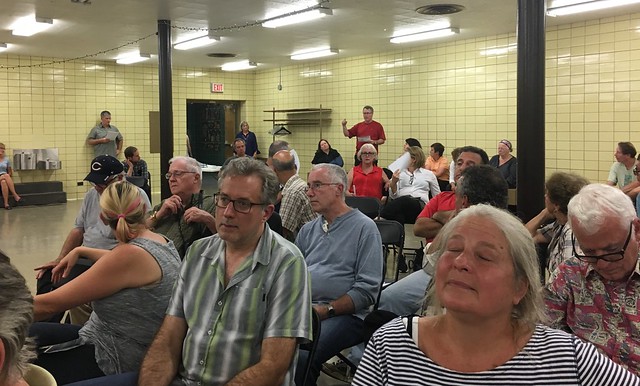Diverter Test on Manor Avenue: “People Have to Change Their Habits”
10:30 AM CDT on September 23, 2016

Last night a group of about 130 people gathered to voice their questions, comments, and concerns, about a car traffic diverter that the Chicago Department of Transportation is testing in Ravenswood Manor. On Monday, CDOT set up two barricades on Manor Avenue at Wilson Avenue that diverts car traffic on Manor approaching Wilson onto Wilson, and prevents vehicle turns from Wilson onto Manor.
CDOT expects the diverter to reduce car traffic volume on Manor, which will "complement" the neighborhood greenway they're building on Manor from Montrose to Lawrence to connect two riverfront multi-use trails. The neighborhood greenway is a set of traffic calming elements, including raised crosswalks at the entrances and shortened crosswalks through the use of bumpouts, to make it more comfortable to walk and bike on the street.
Mike Amsden, assistant director of transportation planning at CDOT, said that the test will end November 18, and that he's been at the intersection three days this week to monitor car and bike traffic and talk to residents. David Smith, a consultant at CDOT, has also been out there each day. Amsden said that this is the highest number of people he's seen attend meetings about city transportation projects he's worked on.
The people who came to the meeting voiced a wide range of ideas about the impact of the barricades, ranging from an unexplained suggestion that the situation is making the intersection a more dangerous place, to commendations of CDOT for actually trying to resolve certain issues and that the test should run its course.

The test involves counting car and bike traffic volumes and driver speeds at 15 locations starting two weeks after the test begins, to allow for an adjustment period. The count locations are within Ravenswood Manor and outside the neighborhood, defined by Sacramento on the west, Lawrence on the north, Montrose on the south, and the river on the east.
Amsden said the diverter was designed to address three goals:
- Reduce car traffic on Manor Avenue
- Simplify the intersection of Manor, Mozart, Wilson
- Create a comfortable corridor for people walking and biking along Manor to access the CTA station and businesses, Ronan and Horner Parks, and the future river trail south of Montrose
In response to the question, "is there another option that might be trialled to figure out the best way" Amsden said that "we came up with several options, we felt this option did the best of addressing those goals."
In between the range of opinions were questions about what other options are if the diverter turns out to be a failure, dissatisfaction about the process, and a claim that setting up the diverter amounted to closing down public streets and was illegal. "Just to be clear," Amsden said, "we didn't close a street."
To explain the process, Alder. Mell's 33rd Ward office had asked Thomas Applegate, a member of the open Transportation Action Committee, to give an overview of the TAC's founding story and discussions during its initial meetings. "In January 2014, even at that [first] meeting, concerns were raised about the volume of car traffic on Manor," he said. "CDOT offered to walk us down Berteau Avenue [in Lakeview, the city's first neighborhood greenway] to show us the traffic calming features" of that project. That happened in July 2014.
It wasn't until a year later that CDOT came back with a handful of proposals. The TAC "reviewed those, but we weren't the only ones." He said that West River Park Neighbors, the Horner Park Advisory Council, and the Horner Park West Neighborhood Association also reviewed them. Later, Athene Carras, president of the Ravenswood Manor Improvement Association, described how her board also reviewed CDOT's proposals, and even voted this summer 6-4 in favor of running the test.
Some people disagree that car traffic volumes are a problem. One attendee said, "This is a contentious issue. I've lived in the Manor for 25 years. This is always a problem. Manor gets twice as much traffic as other streets, and I don't have a problem with that. The thing that bothers me is the speed of the traffic, and people are going 40 and 45 m.p.h., and not stopping at the stop signs."
A number of people in the crowd expressed agreement, so the man responded, "We can all agree on that," and continued, saying, "On my block, there are 26 kids on my block. They bike, they walk, they go to school, they go to Waters [elementary school]. We cannot have people, wherever they live, blowing through our neighborhood."
Amsden replied, "That is what the entire project is about." He explained that there's two components in the project. "One goal of the neighborhood greenway is to slow traffic." He said that the data they collected shows people going "relatively slow, but there are some people going very fast." For the record, the speed limit is 20 m.p.h. The neighborhood greenway's characteristics are to reduce speeds, he said.
As for the second component, Amsden said that "streets like Manor, they have a good amount of traffic, but to get it comfortable for walking and biking, we need to reduce the amount of traffic. And that's what the diverter is intended to do."
Another attendee said she's a real estate agent and drives her car a lot during the day. "I know a lot of the shortcuts everywhere. And when it doesn't work anymore, I find another way. I think the longer this is in place, there's going to be fewer people coming through. I witness a lot of cars parked on my block getting sideswiped. I think this is going to help the situation, but you don't know until you do it for a while. People have to change their habits."
There didn't seem to be any new concerns about the car traffic diverter, which has been up since Monday, and there was no opposition to the neighborhood greenway. It seemed that many people were convinced of the need to collect data about people's behaviors and changing patterns, but others questioned CDOT's method of collecting it, and some suggested additional counting locations.
The next Transportation Action Committee meeting is Thursday, October 27, at 6:30 p.m. at the Horner Park field house. The agenda is to pitch new ideas and discuss new and old transportation issues in the 33rd Ward.
Stay in touch
Sign up for our free newsletter
More from Streetsblog Chicago
The de-facto ban on riverwalk biking is back. What should we do about it?
In the short term, new signage is needed to designate legal areas for cycling on the path. In the long term CDOT should build the proposed Wacker Drive protected bike lane.
Today’s Headlines for Thursday, April 25
It’s electric! New Divvy stations will be able to charge docked e-bikes, scooters when they’re connected to the power grid
The new stations are supposed to be easier to use and more environmentally friendly than old-school stations.




